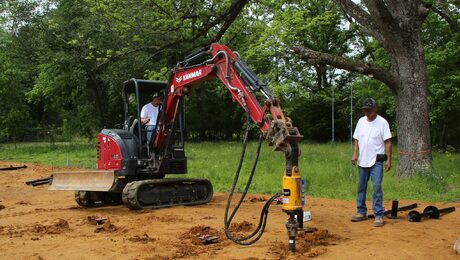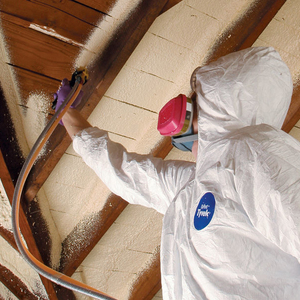Extreme impact sound transmission between floors
Recently I have been wondering if the way I built my house in 1978 caused some extreme impact sound transmission issues. The house is 24×36, 2 floors above a walk-out/garage basement foundation set into a hillside.
Basement ceiling has a 36′ steel girder down the middle supported at 12′ and 24′ by columns (stacked 12″ CMU). The first floor joists are SYP 2×10@16″OC with 12′ span and 3/4″ T&G plywood subfloor glued and nailed. Second floor joists are SYP 2×12@24″OC with 12′ span and 3/4″ T&G plywood subfloor glued and nailed. All walls are 2×6@24″. Wall layers (outside->in) are 5/8″ RB&B redwood plywood, 1/2″ CDX sheathing, 2×6 stud, 5/8″ T-111 pine exterior siding used as interior paneling. T111 instead of drywall provided an indestructible interior surface, great when raising children.
The worst problem has been impact noise passing from the first floor 12×24 kitchen/dining space to the directly-above second floor master bedroom. We have no problems with thru-air sound transmission. Loud conversation in the kitchen/dining area is barely audible upstairs. However first floor impact noise is another story. Opening kitchen drawers is heard loudly in the bedroom. A microwave oven buzzing on the kitchen counter can be clearly heard. Even typing on a keyboard on the breakfast counter sounds like a dull rumble above.
A triple 2X12 first floor ceiling beam supports the interior ends of the bedroom floor joists. The beam spans 8′ from an end wall to a 4X6 post, then 4′ more to a load bearing partition. The center of the bedroom floor is directly over the 8′ and 4′ unsupported portions of the beam. The kitchen is U shaped with a breakfast counter located in the space under the 8′ beam span and work counters that wrap two exterior walls.
Severe noise seems to be coupled directly from the kitchen counters and cabinets through the exterior walls or triple 2X12 beam to the bedroom wall and floor surface above. The 2nd floor bedroom has padded carpet but this does little to abate impact noise from the first floor. Walking around in the kitchen/dining area also causes thud noises that are heard and felt above. Usually impact noise is thought of as impact on an upper floor coming though the ceiling of the floor below. We have the opposite problem – impact on the stiff first floor is coupling through walls and beam support post to the second floor walls and floor.
Perhaps the extreme impact sound transmission occurs because the entire house structure and finish is wood. Floor joists are stiff SYP covered with 3/4 plywood. Walls are 5/8 plywood on both sides. Kitchen cabinets are wood screwed firmly to the exterior wall studs and interior T111 plywood. Kitchen counters use 1″ plywood substrate screwed firmly into the cabinet tops. So everything in the second floor bedroom and the kitchen/dining floor below is a single density (wood) and its all joined tightly together.
We have lived with the impact noises but now are planning a master bedroom renovation. If there is any way to reduce the impact noise level I want to consider it. Also we are planning a house addition that will be about 26×26. I want to understand what I did wrong so I dont do the same thing again. For the addition, I could probably clear span the 26′ length with 16″ I-joists. Or I could make it like the existing house with a basement steel girder and first floor load bearing walls/ceiling beams to halve the joist span to 13′. Is one approach less susceptible to impact sound transmission between floors than the other ?
Any comments or advice would be appreciated.



















Replies
basic physics: sound energy transmission
Hey Mike,
Possible solutions you should give very serious consideration:
one. look at the numerous published diagrams of sound transfer in architectural references.
two. finally after a review of the different sound reducing models you will find two solutions: one is the use of a resilient channel metal building material that shock absorbs the sound energy (acts like a shock absorber), and finally two use mass to stop sound energy transfer (heavy masonary walls) These are the only real solutions that have a great effect. Insulation blankets work also,but their effect is somewhat questionable. You could think of the sound blanket like talkiing through a wool sweater. It works, but is the effect really worth it.
three. mass works (concrete or masonary) one of the benefits of insulated concrete form walls is that inside the home environment they are very, very quiet.
four. You might have a noisy garage door problem. (I didn't look at the complete description of your house) In the wee hours of the morning when someone leaves the house by rolling up the garage door, it is quite bothersome to listen to the garage door roll up. You could go to the trouble of isolation mounts for the opener motor fastening mounts. Basically rubber spacers like the motor mounts of your car. This will help.
The most effective solution is the resilient channel stand offs, and heavy mass. Next best thing is insulation blankets. After that there is a wild solution with an active amplifier system (some ear muffs have noise cancelling systems), but alas our level of science is not at an effective level here yet. This idea really does work, but it is manageable only on a small scale.
Douglas
"Perhaps the extreme impact
"Perhaps the extreme impact sound transmission occurs because the entire house structure and finish is wood."
I suspect you've identified the problem. Carpets absorb a lot of noise, vinyl flooring provides significant damping, tile, by virtue of its weight and the stiffness of the substrate, also cuts noise transmission. Plus, as you say, having all surfaces/structures essentially the same density aggravates the problem. And the 24 pitch of the upper floor joists doesn't help.
But part of the problem is likely that the house is too quiet. A furnace fan running, even at an apparently inaudible level, will reduce the apparent loudness of other sounds, as will a clock quietly ticking, the hum of a computer, etc. You may want to consider actually introducing "white noise" generators into rooms where the noise is particularly bothersome.
As to actually reducing noise transmission, you can add a resiliant ceiling, you can open up the ceiling and add solid blocking to the joists, you can inject cellulose or foam into the ceiling. Each has a different effect. (You may have noticed that, eg, a party next door where people are talking loudly can be much more annoying than people talking in the next room even when the actual volume (at your ear) of the party noise is such lower. This is because you hear essentially the entire sound spectrum from the next room, while from the party you only hear very limited pieces of the spectrum. (Plus, of course, you're annoyed that they didn't invite you.))
Yep, wood is great for conducting sound - that's why they make musical instruments out of it!
I wonder if doing something to break the continuous path of travel would help in this case. He has double diaphram walls, with wood sheathing on both sides (like a drum!).
I've got a couple of ideas on how to kill the sound without making huge changes.
Idea #1: Cut a kerf in your T-111 walls. The kerf can be at the trim line somewhere, but the ide is to break the vertical panels somewhere between top and bottom, and not exactly in the middle either. You then fill the cut with sound caulk and patch it with latex wood putty or a piece of decorative trim. This way the sound loses a floor to ceiling resonating conduction channel.
Idea #2: Cut a 1.5" hole in every stud bay and add 10lbs of sand to the bottom of each stud bay. The wood walls are strong enough to keep from blowing out due to the pressure of the sand; I wouldn't recommend this for drywall. The sound will add both mass AND dampening vibration absorbtion, again killing the sound.
Extreme impact sound transmission
Hi Dan,
You are right about the house being quiet, we are in a rural area where the loudest noises are usually the wind in the trees or water in the nearby creek. A room fan running on low in the 2nd floor bedroom makes enough white noise to mask much of the impact noises.
If we do any major renovation to the bedroom we will probably remove the T111 and replace with 5/8 drywall on top of sound deadening board. We could also replace the fiberglas batt insulation with blown in cellulose. It wouldnt be much more work to add inner walls, making the bedroom exterior walls into double stud walls. That way the only acoustic path for impact noise to the drywall surface would be the wall plates. I think that would eliminate most impact noise radiated by the 2nd floor walls.
Walking on the first floor generates thud noises that propagate to the second floor. Both floor systems are quite stiff. I dont feel any deflection when jumping on them. Are thud noises more related to the floor materials than the stiffness ? The kitchen/dining area has sheet vinyl flooring on 3/4" single layer plywood subfloor. Perhaps a higher mass finish floor would reduce the thud noises. Our woodstove hearth area has 1" soapstone. Pounding on it doesnt make any thud noises.
The lack of sheetrock is your problem - as is you've built your walls about like the body of an acustic guitar! There is a reason for "normal" construction methods. You can help it by insulating all interior walls as well as the floor - celulose is better than fiberglass for this. In the new areas I'd use 5/8" rock - it just deadens sound better.
Extreme impact sound transmission
Hi Don,
I never suspected that I was building a giant guitar or drum, but that is a good description. The interior walls do have fiberglass batts and sound deadening board on 1 side. That works well for attenuating airborne sound.
The first floor is stiff and seems to have some resonance. I see that there is a frequent forum contributor named BossHog who is a truss expert. In one of his posts he mentioned a spreadsheet that calculates floor vibration frequencies. Do you think he would comment on my current floor system and alternative floor systems for the addition ?
You would be shocked at the sound deadening of cellulose blown into floor joists - both sound transmission and noise created by walking on it. I wouldn't have believed the difference if I hadn't seen it on a friends house. It's relatively easy to blow it in before or after sheetrock is installed (well, it's easier before, but not all that hard after the fact if you don't mind patching holesaw cuts at either end of the joist cavity.
Having said that I wouldn't worry too much about the harmonics of your floor - beit trusses, I joists or dimensional lumber - as long as it's dampened with insulation and perhaps the floor covering. I like stiff floors and love really stiff floors.
Strapping a ceiling will also help cut down on noise transmission from above and resilant channels are even better.
If sound transmission is really a concern there is not much that cuts down on sound like concrete/cement based products - and that goes hand in hand with radiant floor heat so if you were a client I'd highly recommend that as well (flooring can be hardwood, tile or carpet over 1-1/2" of concrete if the floor can be built to hold the weight).
The proponents of ditra under tile like it because they can often skip putting down cement board, but I recommend against it and the last time it came up I recommended to an architect client that he not go with the tile installers prefference to simply use ditra and sure enough the floor sounded hollow when walked on and just didn't deaden room sound like it should have. In retrospect the client would have preffered cement board.
In walls I'd look at what kind of mass is the least expensive to install - probably additional layers of sheetrock are more cost effective than some other products since that's whats often spec'ed for commercial space. I know there are articles describing cost benefit of various sound deadening products, but I don't recall the details since I'd normally just go with additional sheetrock and insulation of the stud bays.
I find the sound deadening bitimus mats (seams similar to ice and water shield) interesting. I've heard great things about them on entire walls benith sheetrock, but it is spendy. Similar products are used in the automotive world and it makes a world of difference to block out road and engine noise. If you are getting sounds transmitted from specific small areas perhaps it's cost effective to use those products in small doses. I've long been a fan of wrapping noisy plumbing soil lines with ice and water sheild. I'd like to see a sound transmission test wall with ice and water strips over studs - commercial sound deadening products claim a dramatic decrease.
Along the same lines, I've never heard of the decrease in sound transmission on ceilings if sound deadening strips are used on the faces of the floor joists, but it makes sense that it would be significant. Using simple thin strips suddently becomes more cost effective than covering entire surfaces if the cost/benefit is good.
The bitiminous mats you describe are likely similar in operation to the laminated damping material they use on aircraft. The aircraft mats consist of alternating layers of heavy aluminum foil and a soft rubber-like adhesive. They are adhered to panels in the aircraft to keep them from vibrating like a drum head. They work because as the mat flexes the layers of foil must move parallel to each other, and this stretches the rubber material, expending energy.
I've used pieces of vinyl flooring on furnace panels to achieve the same effect. The vinyl has a relatively stiff top surface with a flexible body that can absorb energy.
Ideally your bituminous mats would contain layers of a relatively stiff material (even paper would work) in addition to the bitumen. But even just a pure bitumen mat between two layers of drywall would be pretty effective.
The 24" pitch of the upper floor is probably not a problem because the joists are not stiff enough, but rather the additional distance (over 16" pitch) creates a larger "drumhead" in the sheathing between joists, increasing sound transmission at certain frequencies.
A standard sheathing-over-joists floor is a "skin-stringer structure" in vibration & damping parlance, and is a very complex structure with many different vibration modes. When I was working with this stuff in the 70s, some coworkers were breaking their picks trying to come up with a computer model of this, since "trivial" things like the stiffness of fasteners could totally change the characteristics of the structure.